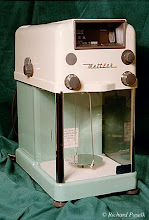If you've been following my blog, you've read stories of airplanes, ants, orphanages, and farms. You might be wondering at what point I would actually do some engineering of the world health variety (ostensibly the reason I'm here). Yesterday (Friday) we finally got our hands dirty with our first visit to a Tanzanian hospital. Mt. Meru hospital is in the heart of Arusha, Tanzania's second largest city after Dar Es Salaam. I admit that I didn't really expect that a large hospital in a large town (population ~300,000) would really have need of the sort of services a bunch of barely-trained students would be capable of offering. I was wrong.
Upon arriving at Mt. Meru we were led to a small workshop next to the hospital's equally small supply room. The room and the veranda in front of it were littered with non-functional equipment in various states of disrepair. Zev, Jason and I first tackled a blood pressure cuff that wouldn't hold pressure. By submerging the hose in a bucket of water we discovered the leak to be coming from a small crack in the tubing right at the hand bulb. 30 seconds' work with a pair of scissors returned the BP cuff to full working order. Other projects were repaired with equal speed: several other BP cuffs, a scale, some foot-powered vacuum pumps, and a centrifuge were repaired with a quick adjustment, reattachment, or other such simple maneuver. I learned that Mt. Meru, despite its size, has not a single technician on staff. We have no idea how long some of this equipment has been sitting (or how long it might have continued to languish) just waiting for someone to take the time to attempt a repair. Time is one of the many luxuries staff at this hospital lack.
Not all the repair attempts had such a happy ending. Two autoclaves (high pressure steam sterilizers) befuddled us and were relegated to the scrap heap. One particular victory, though, was the high point of my day: a scooter for the mobility impaired such as you see at a grocery store. The batteries were fully charged, the horn worked, but the motor would not go. Ben, Ian, Phil and I set about removing every bolt, screw, and coupling we could find. More than one on-looker reminded us that we'd have to put it all back together. I replied that the day fear of reassembly prevents me from attempting a repair will be the day I go home. Some of the plastic cowling proved especially difficult to remove. When it seemed we could go no further, I remembered some wisdom passed down to me by my father, an electrician: "There is no obstacle that cannot be overcome with brute strength and ignorance"; and "Beat to fit, paint to match". After much beating, cranking, and a bit of breaking, we finally uncovered the problem: a small wire had broken off from the potentiometer dial that controlled the motor speed. Ian and I re-soldered the wires, reattached the batteries, and...success! We reattached the wheels and batteries, and, with wires and straps and parts still hanging loose, proceeded to drive victory laps around the veranda.
If only successes came this easily in chemistry research.
Saturday, June 21, 2008
Subscribe to:
Post Comments (Atom)

No comments:
Post a Comment